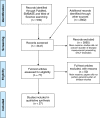Systematic review of general burden of disease studies using disability-adjusted life years
- PMID: 23113929
- PMCID: PMC3554436
- DOI: 10.1186/1478-7954-10-21
Systematic review of general burden of disease studies using disability-adjusted life years
Abstract
Objective: To systematically review the methodology of general burden of disease studies. Three key questions were addressed: 1) what was the quality of the data, 2) which methodological choices were made to calculate disability adjusted life years (DALYs), and 3) were uncertainty and risk factor analyses performed? Furthermore, DALY outcomes of the included studies were compared.
Methods: Burden of disease studies (1990 to 2011) in international peer-reviewed journals and in grey literature were identified with main inclusion criteria being multiple-cause studies that quantified the burden of disease as the sum of the burden of all distinct diseases expressed in DALYs. Electronic database searches included Medline (PubMed), EMBASE, and Web of Science. Studies were collated by study population, design, methods used to measure mortality and morbidity, risk factor analyses, and evaluation of results.
Results: Thirty-one studies met the inclusion criteria of our review. Overall, studies followed the Global Burden of Disease (GBD) approach. However, considerable variation existed in disability weights, discounting, age-weighting, and adjustments for uncertainty. Few studies reported whether mortality data were corrected for missing data or underreporting. Comparison with the GBD DALY outcomes by country revealed that for some studies DALY estimates were of similar magnitude; others reported DALY estimates that were two times higher or lower.
Conclusions: Overcoming "error" variation due to the use of different methodologies and low-quality data is a critical priority for advancing burden of disease studies. This can enlarge the detection of true variation in DALY outcomes between populations or over time.
Figures
References
-
- Murray CJL, Lopez AD. The global burden of disease: A comprehensive assessment of mortality and disability from diseases, injuries and risk factors in 1990 and projected to 2020. Cambridge: Harvard University Press; 1996.
-
- Worldbank. World Development Report 1993: Investing in Health. New York: Oxford University Press; 1993.
-
- Global Burden of Disease (GBD) 2010 study. http://www.who.int/healthinfo/global_burden_disease/GBD_2005_study/en/in...
LinkOut - more resources
Full Text Sources
Miscellaneous




